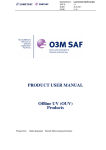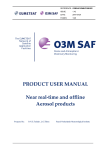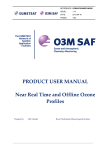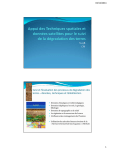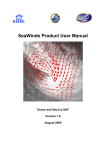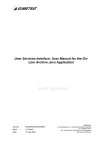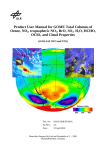Download Product User Manual for OUV
Transcript
Offline UV Product User Manual REF ISSUE DATE PAGE : SAF/O3M/FMI/PUM/001 : 1.3 : 12.02.2009 : 1/19 DOCUMENT TYPE: Product User Manual TITLE: O3M SAF Offline UV Product User Manual PREPARED BY FUNCTION NAME DATE Product Manager Jukka Kujanpää 12.02.2009 SIGNATURE CHECKED BY APPROVED BY DOCUMENT IDENTIFICATION SAF/O3M/FMI/PUM/001 WBS Nr KEYWORDS user manual, format, umarf Offline UV Product User Manual REF ISSUE DATE PAGE : SAF/O3M/FMI/PUM/001 : 1.3 : 12.02.2009 : 2/19 DOCUMENT STATUS SHEET Issue Date Modified Items / Reason for Change 1.0 15.11.2006 Initial revision of the full document 1.1 04.05.2007 -moved algorithm description and error analysis to a separate ATBD as required by EUMETSAT -updated the file naming convention 1.2 04.04.2008 - added error fields 1.3 12.02.2009 - clarified the setting of quality flags in section 3.2.; table 3 in section 5.1.2.; tables 7 and 8 in section 5.1.4. Offline UV Product User Manual REF ISSUE DATE PAGE : SAF/O3M/FMI/PUM/001 : 1.3 : 12.02.2009 : 3/19 TABLE OF CONTENTS 1. INTRODUCTION........................................................................................................... 4 1.1 Purpose and scope ..........................................................................................................................4 1.2 Acronyms .......................................................................................................................................4 1.3 References ......................................................................................................................................4 1.3.1 Applicable Documents.........................................................................................................4 1.3.2 Reference Documents ..........................................................................................................4 2. PRODUCT OVERVIEW ............................................................................................... 5 3. PRODUCT QUALITY ................................................................................................... 7 3.1 Expected Accuracy and Validation ................................................................................................7 3.2 Quality Flags ..................................................................................................................................7 3.3 Current Quality Issues....................................................................................................................8 4. PROCESSING, ARCHIVING AND DISSEMINATION ........................................... 9 4.1 Processing and Archiving ..............................................................................................................9 4.2 Product Ordering............................................................................................................................9 4.3 User Services..................................................................................................................................9 5. PRODUCT FILE FORMAT........................................................................................ 10 5.1 File Structure................................................................................................................................10 5.1.1 METADATA Group..........................................................................................................11 5.1.2 PRODUCT_SPECIFIC_METADATA Group ..................................................................12 5.1.3 GRID_DESCRIPTION Group ..........................................................................................12 5.1.4 GRID_PRODUCT Group..................................................................................................13 5.2 Data Types ...................................................................................................................................17 5.3 File naming convention................................................................................................................17 APPENDIX A. TRACEABILITY OF METADATA TO UMARF PARAMETERS18 Offline UV Product User Manual REF ISSUE DATE PAGE : SAF/O3M/FMI/PUM/001 : 1.3 : 12.02.2009 : 4/19 1. INTRODUCTION 1.1 Purpose and scope This document is the user manual of the O3M SAF Offline UV product (OUV). It includes the definition of the product format. The algorithm and error analysis are described in a separate Algorithm Theoretical Basis Document [RD1]. 1.2 Acronyms ATBD AVHRR CIE EUMETSAT GOME-2 HDF O3M SAF UMARF Algorithm Theoretical Basis Document Advanced Very High Resolution Radiometer Commission Internationale de l'Éclairage, International Commission on Illumination. European Organisation for the Exploitation of Meteorological Satellites Global Ozone Monitoring Experiment, version 2 Hierarchial Data Format Satellite Application Facility on Ozone and Atmospheric Chemistry Monitoring Unified Meteorological Archiving and Retrieval Facility 1.3 References 1.3.1 Applicable Documents [AD1] UMARF to SAFs ICD, EUM/UMA/ICD/004, Issue 3.13, 14 Feb 2007. [AD2] UMARF SAF Metadata Definition, EUM/UMA/TEN/030, Issue 1.7, 09 Feb 2007. 1.3.2 Reference Documents [RD1] OUV Algorithm Theoretical Basis Document, SAF/O3M/FMI/ATBD/001, Issue 1.2, 15.9.2008. [RD2] McKinlay A.F and Diffey B.L., CIE Research Note, 6(1), 1987 [RD3] Setlow R.B., Proc. Nat. Acad. Sci. USA., 71, 3363-3366, 1974. [RD4] Caldwell, M.M. “Solar UV Irradiation and the Growth and Development of Higher Plants”, pages 131-177 in Giese A.G (ed.) Photophysiology, vol 6. Academic Press [RD5] Gruijl F.R. and Van der Leun J.C., Health Phys., 67(4), 319-325, 1994 [RD6] Kinne S. (2007): Towards an observation-tied AOD climatology, presentation in AT2 Aerosol Workshop, Bremen, June 2007. [RD7] Tanskanen, A., (2004) Lambertian surface albedo climatology at 360 nm from TOMS data using moving time-window technique. Proc. XX Quadrennial Ozone Symposium, 18 June, Kos, Greece., pp 1159-1160. [RD8] HDF5 File Format Specification, http://hdf.ncsa.uiuc.edu/HDF5/ Offline UV Product User Manual REF ISSUE DATE PAGE : SAF/O3M/FMI/PUM/001 : 1.3 : 12.02.2009 : 5/19 2. PRODUCT OVERVIEW The O3M SAF offline surface UV product is derived from the measurements of the operational polar orbiting Metop and NOAA satellites. The product contains the most important quantities of the Sun’s radiation that can be harmful to life and materials on the Earth. These quantities include daily doses and maximum dose rates of integrated UV-B and UV-A radiation together with values obtained by different biological weighting functions, solar noon UV index and quality control flags. The product is calculated in a 0.5 degree regular grid and stored in a HDF5 file. The contents of the product file are listed in chapter 5. An example of the daily erythemal dose product is shown in figure 1 below. Figure 1. An example product field. Erythemal (CIE) daily dose [kJ/m2] on 20 June 2007. The global coverage is limited by the swath of GOME-2 instrument, leaving stripes at low latitudes. The polar night and large solar zenith angles limit the coverage at the winter pole. The biological weighting functions (also known as action spectra) model responses of different biological entities to UV radiation. The currently applied functions are plotted in Figure 2 and a short description of their meaning is given in Table 1. 10 CIE DNA PLANT SCUP-h 1 0.1 0.01 0.001 1e-04 1e-05 300 320 340 360 wavelength [nm] 380 400 Figure 2. The biological weighting functions (table 1) used in the OUV product: CIE (red), DNA (green), Plant (blue) and SCUP-h (purple). Offline UV Product User Manual REF ISSUE DATE PAGE : SAF/O3M/FMI/PUM/001 : 1.3 : 12.02.2009 : 6/19 Table 1. Description of the biological weighting functions used in the OUV product. Weighting function Ref. Description CIE [RD2] Most often used weighting function. It is also known as the erythemal weighting function, because it measures the reddening of the skin due to sunburn. DNA [RD3] Measures the ability of UV irradiance to cause damage to unprotected DNA. Normalization to 1.0 at 300 nm is used (normalization to 265 nm is divided by 0.0326) Plant [RD4] Measures the generalized response of plants to UV irradiance. Normalization to 1.0 at 300 nm is used (normalization to 280 nm is divided by 0.2176) SCUP-h [RD5] Skin Cancer Utrecht-Philadelphia action spectrum, adjusted for human skin. Measures the incidence of skin cancer (squamous cell carcinoma in human skin, SCC). The key factors affecting the surface UV radiation are ozone, clouds, aerosols and surface albedo. The sources of these key factors are described below. The total ozone is obtained from the O3M SAF near real time total column ozone product (NTO). This product is made by German Aerospace Center (DLR) and disseminated via the EUMETCast broadcasting system. It is derived from the measurements of the GOME-2 instrument onboard Metop satellites. The cloud optical depth is estimated from AVHRR channel 1 (visible) reflectances. AVHRR is also onboard the Metop satellites. The sampling of the diurnal cloud cycle is improved by using additional AVHRR data from the NOAA satellites, available through the data exchange between EUMETSAT and NOAA. Because Metop is on a morning orbit and NOAA satellite on the afternoon orbit, at least two samples of the diurnal cycle can be obtained globally (Figure 3). More overpasses are available at high latitudes where the instrument swaths overlap for consecutive orbits. This sampling scheme provides a sufficient compromise between the global coverage and sampling of the diurnal cycle. Moreover, the processing data flow can be kept relatively simple because both the Metop and NOAA AVHRR data are available through EUMETCast. Metop 9:30 NOAA 14:30 Figure 3. The diurnal cycle of UV dose rate (clear-sky case shown for clarity) together with the sampling achieved by Metop and NOAA AVHRR measurements. The sampling of the diurnal cycle is improved at high latitudes where the instrument swaths overlap for consecutive orbits. The aerosol optical depth is currently taken from climatology [RD6], and the surface albedo from the climatology of Tanskanen [RD7]. Offline UV Product User Manual REF ISSUE DATE PAGE : SAF/O3M/FMI/PUM/001 : 1.3 : 12.02.2009 : 7/19 3. PRODUCT QUALITY 3.1 Expected Accuracy and Validation The target product accuracy is 20 % against ground-based UV measurements. The surface UV product is validated by a validation service. This service, also located at FMI, performs two different validation activities. Firstly, online quality checks are made within the first 30 days of product processing to detect possible degradation of the product quality. These quality checks are performed with preliminary ground-based reference data. Secondly, the UV product is fully validated against quality-checked ground-based measurements. These results are provided as half-yearly validation reports. These validation reports will be available on the O3M SAF web site at http://o3msaf.fmi.fi. 3.2 Quality Flags Quality flags (table 7 in section 5.1.4) are set during the processing to indicate degraded product quality. Figure 4 shows example plots of the quality flags. These quality flags should be carefully examined when using the product. In order to simplify basic quality control, three summary flags (table 8 in section 5.1.4) have been designed: QC_MISSING, QC_LOW_QUALITY and QC_MEDIUM_QUALITY. The user is encouraged to use these summary flags as follows: • If no quality checking is wanted, then the data with QC_MISSING equal to 1 should be discarded. This is equally achived by checking for fill values in the data. • Good and slightly degraded data are obtained by discarding data with QC_LOW_QUALITY equal to 1 • Good data are obtained by discarding all data with QC_MEDIUM equal to 1. The quality flagging procedure will be refined based on the feedback from the validation reports, and therefore the mapping in table 8 may change in the future. Figure 4. Example plots of the quality flags. The red color indicates where the flag is on. (left) The polar night flag is set when the solar zenith angle is larger than 88 degrees and (right) the low quality flag is set when it is larger than 70 degrees. The low quality flag is also set for other conditions, such as ice sheets, other areas with high surface albedo and areas where not insufficient cloud data were available Offline UV Product User Manual REF ISSUE DATE PAGE : SAF/O3M/FMI/PUM/001 : 1.3 : 12.02.2009 : 8/19 3.3 Current Quality Issues The estimation of effective cloud optical depth from the AVHRR reflectances becomes prone to errors if the solar zenith angle is larger than 70 degrees or if the surface albedo is high, and therefore the corresponding product values are flagged as of low quality. The product values are also flagged if insufficient cloud data were available for the calculation of the diurnal integral. Climatological values are currently used for surface albedo and aerosols. The surface albedo climatology fails during snow falling and melting periods, which vary from year to year. The aerosol climatology, on the other hand, tends to underestimate the aerosol loading in the boundary layer, especially during the summer time. Offline UV Product User Manual REF ISSUE DATE PAGE : SAF/O3M/FMI/PUM/001 : 1.3 : 12.02.2009 : 9/19 4. PROCESSING, ARCHIVING AND DISSEMINATION 4.1 Processing and Archiving The offline UV product is produced operatively with a maximum delay of 15 days between the satellite measurements and the dissemination to the users. The actual delay depends on the operational computing environment and on possible delays in getting the input data from different sources. The overall processing scheme is described below. The input near real time total column ozone product (NTO) is produced by the German Aerospace Center (DLR). It is sent to the EUMETCast uplink station at Usingen, Germany, where it is broadcasted via telecommunication satellites (Hot Bird). The NTO product is received at FMI, together with input AVHRR level 1b products both from MetOp and NOAA satellites. The output OUV product is stored in the FMI Archive, from where it can be accessed via the Unified Meteorological Archive and Retrieval Facility (UMARF) at EUMETSAT. The processing data flow is depited in figure 5 below. NTO Hot Bird EumetCast uplink station at Usingen Metop AVHRR LAC NOAA AVHRR GAC EumetCast reception station at FMI OUV processor NTO OUV product DLR FMI Archive Order request UMARF Product order Product order User Product delivery Figure 5. Overall processing data flow. 4.2 Product Ordering After the integration of SAF products to the EUMETSAT Unified Meteorological Archive and Retrieval Facility (UMARF), the HDF5 files can be ordered from UMARF at http://archive.eumetsat.int/umarf. The product order will be transmitted to the FMI Archive, and the user will receive an e-mail containing the instructions on how to download the data files. 4.3 User Services The helpdesk can be accessed through the O3M SAF web site at http://o3msaf.fmi.fi, or by by sending e-mail to [email protected]. Offline UV Product User Manual REF ISSUE DATE PAGE : SAF/O3M/FMI/PUM/001 : 1.3 : 12.02.2009 : 10/19 5. PRODUCT FILE FORMAT This section describes the HDF5 format [RD8] of the offline UV product. 5.1 File Structure The data in the HDF5 file is organized under four groups: METADATA, PRODUCT_SPECIFIC_METADATA, GRID_DESCRIPTION and GRID_PRODUCT. The file structure is shown in Figure 6. The values in all groups are either copied from the input data or calculated by the processor. / METADATA PRODUCT_SPECIFIC_METADATA GRID_DESCRIPTION GRID_PRODUCT Figure 6. Structure of the HDF5 file. The METADATA group contains the parameters required by UMARF [AD1] [AD2] while the PRODUCT_SPECIFIC_METADATA group is used for additional information specific to this product. The product fields are stored in a regular longitude-latitude grid. The grid parameters are stored as attributes of the GRID_DESCRIPTION group whereas the product fields are stored as datasets in the GRID_PRODUCT group. The x-dimension of the grid is the longitude and the ydimension is the latitude. The product fields are two-dimensional arrays of floating point or integer data. If a value for a grid cell cannot be calculated, a fill value is written to the array. Each array has five attributes: Title, Unit, FillValue, ValidRangeMin and ValidRangeMax. These are used to describe the contents of the array. The organization of the data is illustrated in Figure 7. YNumCells Latitude (y) XNumCells YStepDeg YStartLat Longitude (x) XStartLon XStepDeg Figure 7. Organization of the product fields in the HDF5 file. Offline UV Product User Manual REF ISSUE DATE PAGE : SAF/O3M/FMI/PUM/001 : 1.3 : 12.02.2009 : 11/19 5.1.1 METADATA Group The content of the METADATA group is shown in the following table. All parameters are stored as attributes of the group. The allowed values for the parameters that are required by UMARF are consistent with the requirements given in [AD2]. The allowed values given in italics mean any value of the given type (e.g. string means that the attribute can contain any string, within the UMARF size limit). Table 2. METADATA group contents. Attribute name Data Type Description Allowed values SatelliteID string Platform identifier (mission and spacecraft the product originated from). M01,M02,M03, N15,N16,N17,N18 , N19 etc. OrbitType string Orbit type of the spacecraft, indicating the coverage of the product. LEO InstrumentID string Instrument which acquired the product. GOME,AVHR SensingStartTime string UTC date and time at acquisition start of the product. YYYY-MMDDThh:mm:ss.ddd SensingEndTime string UTC date and time at acquisition end of the product. YYYY-MMDDThh:mm:ss.ddd ProcessingCentre string Centre that generated the data. O3FMI ProcessingLevel string Processing level applied for generation of the product. 03 ProcessingMode string Processing mode applied for generation of the product N=Nominal, B=Backlogged, R=Reprocessed, V=Validation ProcessingTime string UTC date and time at processing end of the product. YYYY-MMDDThh:mm:ss.ddd ReferenceTime string Time at which the product is defined to be valid. Same value as ProcessingTime ProductAlgorithmVersion string Version of the algorithm that produced the product. String<4> ParentProducts string A list of the name of the parent products, upon which the product is based. NTO, AVHRR_level_1b BaseAlgorithmVersion string Version of the NTO product. String<4> ProductType string Abbreviated name for the product type, or rather product category. O3MOUV ProductFormatVersion string Version number of the product format (= Issue of this User Manual document) String<4> OverallQualityFlag string Overall quality flag for the product. OK or NOK QualityInformation string Several miscellaneous quality indicators for the product. String<511> Offline UV Product User Manual REF ISSUE DATE PAGE : SAF/O3M/FMI/PUM/001 : 1.3 : 12.02.2009 : 12/19 Attribute name Data Type Description Allowed values DegradedRecordCount int Number of degraded product values. Int DegradedRecordPercentage int Percentage of degraded product values. Int 0 – 100 MissingDataCount int Number of missing product values. Int MissingDataPercentage int Missing data percentage. Int 0 – 100 GranuleType string Type description of the item. DP MapProjection string Projection used by the product Geographic DispositionMode string Disposition mode applied for generation of the product O = Operational, P = Pre-operational 5.1.2 PRODUCT_SPECIFIC_METADATA Group The product specific metadata are listed in the following table. Table 3. PRODUCT_SPECIFIC_METADATA group contents. Attribute name Data type Unit Description LowSunNoonSza float degree Limiting solar noon zenith angle for setting the QC_LOW_SUN quality flag. PolarNightNoonSza float degree Limiting solar noon zenith angle for setting the QC_POLAR_NIGHT quality flag. ThickCloudsCod float none Limiting cloud optical depth for setting the QC_THICK_CLOUDS quality flag. HighAlbedoClearSky float none Limiting surface albedo for setting the QC_HIGHALB_CLEARSKY quality flag. HighAlbedoClearSkyPatm float atm Limiting surface pressure for setting the QC_HIGHALB_CLEARSKY quality flag. InhomogeneousSurfaceHeightLimit float m Limiting surface height deviation for setting the QC_INHOMG_SURFACE quality flag. InhomogeneousSurfaceAlbedoLimit float none Limiting surface albedo deviation for setting the QC_INHOMG_SURFACE quality flag. 5.1.3 GRID_DESCRIPTION Group The grid parameters are stored as attributes of the GRID_DESCRIPTION group. The attributes are given in the following table. Offline UV Product User Manual REF ISSUE DATE PAGE : SAF/O3M/FMI/PUM/001 : 1.3 : 12.02.2009 : 13/19 Table 4. GRID_DESCRIPTION group contents. Attribute name Data type Unit Description XNumCells int N/A Number of grid cells in the X direction YNumCells int N/A Number of grid cells in the Y direction XStartLon float degree Longitude of the centre of the first grid cell in the X direction. Longitude ranges from -180 to +180. YStartLat float degree Latitude of the centre of the first gird cell in the Y direction. Latitude ranges from -90 to +90. XStepDeg float degree Step (increment) between the grid cells in the X direction YStepDeg float degree Step (increment) between the grid cells in the Y direction 5.1.4 GRID_PRODUCT Group The datasets in the GRID_PRODUCT group are given in the following table. The daily doses, daily maximum dose rates and their error estimates are stored for the following four different biological weightings: erythemal (“CIE”), DNA damage (“DNA”), generalized plant response (“Plant”) and SCUP-h, together with integrated UV-B (280-315 nm) and UV-A (315-400 nm) radiation. In addition, the solar noon UV index and its error estimates are stored. Attributes attached to all datasets in this group are listed in table 6. The contents of the QualityFlags and the setting of the summary flags are listed in tables 7 and 8. Table 5. GRID_PRODUCT group contents. Dataset name Data type Unit Description DailyDoseCie float kJ/m2 Daily UV dose, CIE weighting DailyDoseCieLow - low dose estimate DailyDoseCieHigh - high dose estimate DailyDoseDna float kJ/m2 DailyDoseDnaLow - low dose estimate DailyDoseDnaHigh DailyDosePlant Daily UV dose, DNA damage weighting - high dose estimate float 2 kJ/m Daily UV dose, Plant response weighting DailyDosePlantLow - low dose estimate DailyDosePlantHigh - high dose estimate DailyDoseScuph float kJ/m2 Daily UV dose, SCUP-h weighting DailyDoseScuphLow - low dose estimate DailyDoseScuphHigh - high dose estimate DailyDoseUvb DailyDoseUvbLow float kJ/m2 Daily UV dose, integrated UV-B (280-315 nm) - low dose estimate Offline UV Product User Manual Dataset name Data type Unit - high dose estimate float kJ/m2 Daily UV dose, integrated UV-A (315-400 nm) DailyDoseUvaLow - low dose estimate DailyDoseUvaHigh DailyMaxDoseRateCie - high dose estimate float 2 mW/m Daily maximum dose rate, CIE weighting DailyMaxDoseRateCieLow - low dose rate estimate DailyMaxDoseRateCieHigh - high dose rate estimate DailyMaxDoseRateDna float mW/m2 DailyMaxDoseRateDnaLow - high dose rate estimate float 2 mW/m DailyMaxDoseRatePlantLow Daily maximum dose rate, Plant response weighting - low dose rate estimate DailyMaxDoseRatePlantHigh DailyMaxDoseRateScuph Daily maximum dose rate, DNA damage weighting - low dose rate estimate DailyMaxDoseRateDnaHigh DailyMaxDoseRatePlant - high dose rate estimate float 2 mW/m Daily maximum dose rate, SCUP-h weighting DailyMaxDoseRateScuphLow - low dose rate estimate DailyMaxDoseRateScuphHigh - high dose rate estimate DailyMaxDoseRateUvb float mW/m2 DailyMaxDoseRateUvbLow Daily maximum dose rate, integrated UV-B (280-315 nm) - low dose rate estimate DailyMaxDoseRateUvbHigh DailyMaxDoseRateUva - high dose rate estimate float 2 mW/m Daily maximum dose rate, integrated UV-A (315-400 nm) DailyMaxDoseRateUvaLow - low dose rate estimate DailyMaxDoseRateUvaHigh - high dose rate estimate SolarNoonUvIndex float N/A Solar noon UV index SolarNoonUvIndexLow - low index estimate SolarNoonUvIndexHigh - high index estimate QualityFlags : SAF/O3M/FMI/PUM/001 : 1.3 : 12.02.2009 : 14/19 Description DailyDoseUvbHigh DailyDoseUva REF ISSUE DATE PAGE int N/A Quality flags for the product. See table 7 for interpretation of the bits. Offline UV Product User Manual REF ISSUE DATE PAGE : SAF/O3M/FMI/PUM/001 : 1.3 : 12.02.2009 : 15/19 Table 6. Attributes for the GRID_PRODUCT group datasets. Attribute name Data Type Description Title string Description of the dataset, e.g. "Solar noon UV index" Unit string Unit of the values in the array, e.g. second FillValue same as the dataset Number in the array, if actual data value is missing ValidRangeMin same as the dataset Minimum allowed value for the data in the array ValidRangeMax same as the dataset Maximum allowed value for the data in the array Table 7. Interpretation of the QualityField. Flags have the value 1 for on and 0 for off. Bit Name Description 0 QC_MISSING Data are missing. See table 8 on summary flags. 1 QC_LOW_QUALITY At most low quality expected. See table 8 on summary flags. 2 QC_MEDIUM_QUALITY At most medium quality expected, See table 8 on summary flags. 3 QC_INHOMOG_SURFACE The surface UV varies too much within the grid cell because of surface inhomogenity. The flag is set if: - surface height within the grid cell deviates from the mean value more than the value InhomogeneousSurfaceHeightLimit given in the product specific metadata field (table 3). - surface albedo within the grid cell and its nearby neighbours deviates more than the value InhomogeneousSurfaceAlbedoLimit given in the product specific metadata field (table 3). 4 OC_POLAR_NIGHT Polar night. The solar zenith angle is larger than the value PolarNightNoonSza given in the product specific metadata field (table 3). 5 QC_LOW_SUN The Sun is too low for reliable radiative transfer modelling of surface UV. The threshold solar zenith angle is given in the LowSunNoonSza attribute of the product specific metadata field (table 3). 6 QC_OUTOFRANGE_ INPUT Out of range input data was detected, but the value could still be used in processing. 7 QC_NO_CLOUD_DATA No cloud data were available. 8 QC_POOR_DIURNAL_ CLOUDS Poor diurnal cloud coverage. This flag is set when insufficient cloud data are available to cover the diurnal cloud cycle. 9 QC_THICK_CLOUDS Thick clouds were observed. This flag is set when optically thick clouds are observed during the day. Saturation of the atmospheric reflectance as a function of the cloud optical depth prevents accurate estimation of the cloud optical depth, and therefore, the surface UV flux cannot be accurately determined. The threshold cloud optical depth is given in the ThickCloudsCod attribute of the product specific metadata field (table 3). Offline UV Product User Manual REF ISSUE DATE PAGE : SAF/O3M/FMI/PUM/001 : 1.3 : 12.02.2009 : 16/19 Bit Name Description 10 QC_ALB_CLIM_IN_ DYN_REG Surface albedo climatology was used in a dynamic region where albedo varies with the snow and ice cover. 11 QC_LUT_OVERFLOW Look-up table limits were exceeded and a value was extrapolated. 12 QC_HIGHALB_CLEARSKY Clear-sky was assumed if surface albedo was larger than the value HighAlbedoClearSky and surface pressure was smaller than the value HighAlbedoClearSkyPatm given in the product specific metadata field. 13-15 reserved for future use 16-19 QC_OZONE_SOURCE 4 bits as an integer: source of total column ozone data. In the current version this is always 0 meaning GOME-2 total ozone (NTO or OTO) 20-23 QC_NUM_AM_COT 4 bits as an integer: number of cloud optical thickness observations in the morning, value 15 indicating 15 or more observations. 24-27 QC_NUM_PM_COT 4 bits as an integer: number of cloud optical thickness observations in the afternoon, value 15 indicating 15 or more observations. 28-31 QC_NOON_TO_COT 4 bits as an integer: minimum time in hours (rounding towards zero) between the solar noon and the nearest cloud optical thickness (COT) observation Table 8. Mapping of the quality flags to summary flags. Summary flag Summary flag is on if any of these flags is on. QC_MISSING QC_POLAR_NIGHT QC_NO_CLOUD_DATA QC_LOW_QUALITY QC_MISSING QC_LOW_SUN QC_OUTOFRANGE_INPUT QC_LUT_OVERFLOW QC_MEDIUM_QUALITY QC_LOW_QUALITY QC_POOR_DIURNAL_CLOUDS QC_HIGHALB_CLEARSKY QC_INHOMOG_SURFACE QC_THICK_CLOUDS QC_ALB_CLIM_IN_DYN_REG Offline UV Product User Manual REF ISSUE DATE PAGE : SAF/O3M/FMI/PUM/001 : 1.3 : 12.02.2009 : 17/19 5.2 Data Types The data types to be used in the HDF5 files are given in the table below. Table 9. Data types for the HDF5 files. Data type HDF5 predefined data type char H5T_STD_I8LE short int H5T_STD_I16LE int H5T_STD_I32LE float H5T_IEEE_F32LE double H5T_IEEE_F64LE string Fortran: H5T_FORTRAN_S1 C: H5T_C_S1 5.3 File naming convention The file naming convention of the OUV product is shown in Figure 8. O3MOUV_L3_YYYYMMDD_v01p00.HDF5 processor version, minor processor version, major day month year Figure 8. The structure of the OUV file name. Offline UV Product User Manual REF ISSUE DATE PAGE : SAF/O3M/FMI/PUM/001 : 1.3 : 12.02.2009 : 18/19 APPENDIX A. TRACEABILITY OF METADATA TO UMARF PARAMETERS This appendix contains details related to the interface between the UMARF catalogue and the FMI archive. The UMARF metadata parameters [AD2] which are applicable to the O3MSAF products are stored in the HDF5 file as attributes in the Metadata group (Table 2). The tracing of UMARF parameters to the attributes in the product file is shown in the following table. The attributes can only have values which are allowed by UMARF. UMARF Short Name Attribute Name Notes ASTI SatelliteID - GORT OrbitType - LONS N/A Start Orbit Number LONE N/A End Orbit Number LLAS N/A SubSatellitePointStartLat LLOS N/A SubSatellitePointStartLon LLAE N/A SubSatellitePointEndLat LLOE N/A SubSatellitePointEndLon LSVT N/A Ascending Node Crossing Date and Time OCSA N/A Occultation Satellite ID (TBC) OCLA N/A Occultation Latitude (TBC) OCLO N/A Occultation Longitude (TBC) OCTM N/A Occultation Date and Time (TBC) AIID InstrumentID - SMOD N/A InstrumentMode SSBT SensingStartTime - SSST SensingEndTime - ABID N/A Spectral Band IDs GNSP N/A Number of Spectral Bands RRCC N/A ReceivingCentre RRBT N/A Reception Start Date and Time RRST N/A Ibid. End Date and Time PPRC ProcessingCentre PPDT N/A Processing Start Date and Time PPST ProcessingTime Processing End Date and Time GPLV ProcessingLevel - Offline UV Product User Manual REF ISSUE DATE PAGE : SAF/O3M/FMI/PUM/001 : 1.3 : 12.02.2009 : 19/19 UMARF Short Name Attribute Name Notes AVBA BaseAlgorithmVersion - AVPA ProductAlgorithmVersion - LMAP Map Projection - LSCD N/A SpatialCoverageModel APXS N/A PixelSize SNIT ReferenceTime - AENV N/A SourceEnvironment GDMD Disposition Mode - GPMD ProcessingMode - APNM ProductType - APNA N/A Unique product identifier used in the O3M SAF archive; not included in the product file, provided to UMARF by archive software APPN ParentProducts - APAS Added by Archive Product Actual Size; not included in the product file, provided to UMARF by archive software GNPO N/A Native Pixel Order GNPF N/A ProductFormatType GNFV ProductFormatVersion - QCCV N/A Cloud Coverage QQOV OverallQualityFlag - QQAI QualityInformation - QDRC DegradedRecordCount - QDRP DegradedRecordPercentage - QDLC MissingDataCount - QDLP MissingDataPercentage - AARF Added by Archive Archive Facility; not included in the product file, provided to UMARF by archive software UUDT N/A Ingestion Date and Time GGTP GranuleType - UDSP N/A DispositionFlag, UMARF internal



















